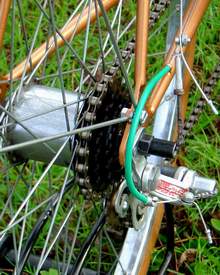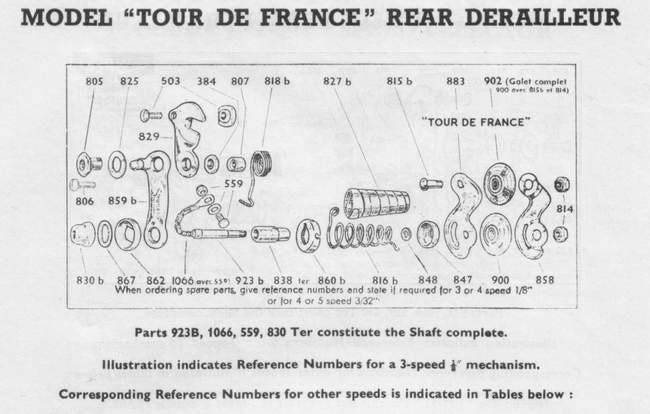Hybrid Hub/Derailleur Gears
Posted: Monday 21st September 2020
For my twelfth birthday way back in 1960, my parents presented me with my dad’s old Raleigh Lenton Sports, refurbished with many new parts, including a Sturmey Archer AW 3-speed hub. As my interest in cycling (and especially touring and roughstuff) quickly grew, I began to question the received wisdom that “no one needs more than three gears”. Fierce local climbs like Yorkshill and Carter’s Hill near Sevenoaks, Hucking Hill near Maidstone and, slightly further afield, Ditchling Beacon and Steyning Round Hill in Sussex certainly suggested otherwise, particularly when carrying a saddlebag full of food for a self-catering hostel weekend.
Being short of cash, and having to rely on a small amount of money earned on a paper round, I looked for a way of increasing my range of gears at minimal expense. The solution I hit on was to fit a Cyclo 2-speed converter based on the Cyclo Benelux Mark 7 derailleur to the Sturmey. In this way, I doubled my number of gears without incurring the cost of a new hub and rebuilt wheel. I also avoided ending up with a redundant yet almost new 3-speed hub gear, which would have annoyed my parents no end, and rightly so! With a 19-25T Cyclo block, I gained a range of gears from 33 to 84 inches. This arrangement served me well, being used on my first ever solo week-long tour of mid-Wales in 1962 right through to a three-week tour of Denmark and Sweden in 1978.
For the classic lightweight enthusiast wishing to recreate a period touring machine, the hybrid arrangement of hub gear and derailleur is an attractive option. To some, it might appear to be the worst of both worlds, incurring the disadvantages of hub gearing as well as those of derailleurs, but there are significant advantages. You get a good range of gears without any necessity to dish the rear wheel significantly, it’s possible to change at least some of the gears when stationary, and all gears are usable which, because of substantial chain misalignment, is not generally the case with multiple sprockets and chainwheels. And, of course, you are keeping alive the spirit of cycle touring in a bygone age!

By far the best known and easiest to replicate hybrid system is that based on Cyclo products. This well-known company produced 2- and 3-speed converter blocks from the 1940’s into the 1980’s, so you can have period-correct hybrid gearing on a wide range of classic lightweights. The blocks simply slotted on or screwed on to the SA driver, depending on whether the driver was splined or threaded, respectively. The earliest example I am aware of is that on page 167, Figure 8.89, of Frank Berto’s The Dancing Chain, which shows a hybrid system dated 1949. Cyclo were still in the business as late as 1981 according to the Sturmey Archer Heritage site .
Their converters were all made for a 1/8-inch chain. Although it is possible in principle to use a variety of derailleur mechanisms, these have to be capable of accommodating the 1/8-inch chain without fouling the chain cage and need to be adjustable down to the narrow range of travel necessary for just 2- or 3-speeds. Unsurprisingly, Cyclo pushed their own mechanisms and as late as 1981 were still marketing a conversion kit featuring the Cyclo Benelux Mark 7 changer dating from 1957, which I used in the early 60’s!
Assuming you start with a built-up hub gear wheel, fitting a Cyclo conversion should be straightforward. The above link to the Sturmey-Archer Heritage Site provides basic instructions. Cyclo 2- and 3-speed conversion blocks turn up regularly on Ebay, or can usually be purchased from V-CC members dealing in vintage components as listed in the Directory of Services in the centre pages of the current (2007-08) Yearbook. The same goes for a suitable gear mechanism. Because Cyclo marketed the Mark 7 derailleur as part of their conversion kit for so long, this mechanism is an appropriate choice for any post-1957 cycle. Fitting the block can be as simple as removing the circlip on the splined SA driver, taking off the single sprocket, sliding on the 2- or 3-speed replacment, and replacing the circlip. Note that the dust cap should be left in position. For the 3-speed conversion, it is recommended to fit a 1/8-inch axle washer to each side to give extra width and stop the smallest sprocket fouling the frame. This will increase the over-locknut distance by just over 6 mm, and may require you to fit a longer axle, replacing the standard 5¾-inch axle with a 6¼-inch one.
For everything to work, since the SA hub is some 110 or 112 mm across the lock nuts, your rear dropout width should be in the range 115 to 120 mm. If you are lucky, no dishing or re-dishing will be necessary. In the worst case, you may need a very small amount of re-dishing. Needless to say, things are likely to be easier with the 2-speed conversion, reducing the likelihood that you will need to fit a longer axle and/or re-dish the wheel.
Please take a look at my 1949 Gillott Spearpoint fitted with a 12-speed hybrid system ranging from 32 to 86 inches. I am indebted to my friend Geoff Cook for his assistance in putting this hybrid gearing system together. The hub is a very nice 1948 FW 4-speed obtained from Rob Burton in Bognor Regis. The block is a Cyclo 3-speed, 16-19-23T, obtained from Nick Tithecott of H Lloyd Cycles, Penrith, who also supplied the 1952 Cyclo Benelux Sport gear mechanism. The latter is not quite period-correct, but my plans to use a 1948 Cyclo Super Olympic Professional were scuppered by its very limited capacity (just four teeth, by virtue of its single-roller design).
Geoff Cook supplied the long SA axle from his stock made in the 60’s and 70’s for Moultons and Raleigh RSW16 shoppers, which had wider dropouts. With Geoff’s considerable help, we replaced the screw-threaded SA driver with a splined one to match Nick Tithecott’s block, replaced the axle with the longer one, added the axle washers for extra spacing, and had a happy time adjusting the Cyclo gear. This was not entirely a simple matter (see Peter Brueggeman’s Adjusting Benelux Gears) although it was a breakthrough when I realised that old Cyclo derailleurs have no high-gear adjustment! The actuating rod is simply machined to what ought to be the right length to give the correct travel for the block in use. This means it’s very important to look at the stamping on the gear cage. If it says 3 sp 1/8″ ONLY, that’s what you get (unless you change the actuating rod).
I have encountered one minor problem in that the dropout axle slots on the Gillott are ever so slightly too wide for the SA axle, which has flats on it. This is no doubt because the frame was built for a gear/fixed hub without axle flats. It means that the SA axle has a tendency to rotate in the frame. I minimise this by using SA washers that locate on the axle flats and have `protuberations’ designed to mate into the axle slots. This is not such a problem with bikes that were made to take an SA hub gear, and have narrower dropout slots to suit.
If you wish to read more on this topic, there’s a small amount of additional information in Appendix C, “Hybrid Gearing”, of Tony Hadland’s 1988 book The Sturmey Archer Story. Tony includes mention of products from manufacturers other than Cyclo, such as Dacon. My own experience, however, is limited to Cyclo.
I had a very frustrating attempt to fit a Cyclo conversion to Penny’s FM hub on her Claud Butler. The problem was that the hub did not freewheel easily. The derailleur conversion block kept rotating when you attempted to freewheel, the chain went slack, the crank end hit the sloppy chain, chaos! The problem with the FM is the large amount of internal friction during freewheeling, which causes the gear internals (and so the pedals also) to rotate unless opposed by some small force. With the normal set-up, the rider applies this small force naturally via the tension of the bottom run of the chain when freewheeling. But with a derailleur mechanism in place, freewheeling causes the tensioning arm to detension the bottom run of chain, with consequent bad effects (e.g., chain comes off)! We had a look in the SA Service manual and found that this is normal for certain SA hubs.
Page 15 of Sturmey Archer’s Service Manual says:
“The gear internals are rotated during freewheeling in FM, FC and AC hubs, therefore, providing cones are properly adjusted, a slight pull on the pedals and possible rotation during freewheeling is in order.”
For this reason, these hubs are not suitable for conversion to hybrid gearing, as any rotation during freewheeling leads to loss of chain tension and possible disastrous chain derailment. There should be no such problems, however, with the widely-used FW and AW hubs.
Posted: Monday 21st September 2020
This article appears in the following categories.
Upcoming Events
Whether you are looking for a gentle social meet up, or a 100-mile ride browse the community’s upcoming events and plan your next weekend outing.
